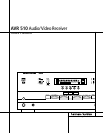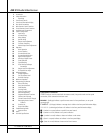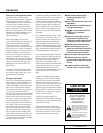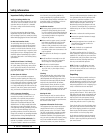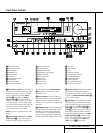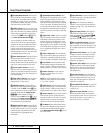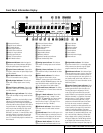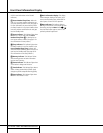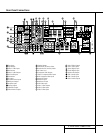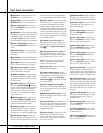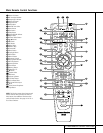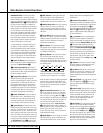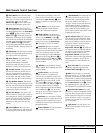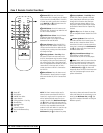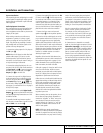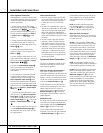
6 FRONT PANEL CONTROLS
Front Panel Controls
7 Surround Mode Selector: Press this but-
ton to change the surround mode by scrolling
through the list of available modes. Note that
depending on the type of input, some modes
are not always available. (See page 27 for more
information about surround modes.)
8 Tuning Selector: Press the left side of the
button to tune lower-frequency stations and the
right side of the button to tune higher-frequency
stations. When a station with a strong signal
is reached, the
TUNED indicator W will be lit
in the
Main Information Display Û .
To tune manually, tap the button lightly and
note that the tuner will step up one frequency
increment per button press. When the button is
held for a few seconds you will note that the
unit will quickly search the frequency band.
Release it once the fast tuning starts; the tuner
will automatically scan for the next station with
an acceptable signal and then stop.
9 Tuner Band Selector: Pressing this button
will automatically switch the AVR 510 to the
Tuner mode. Pressing it again will switch
between the AM and FM frequency bands. (See
page 30 for more information on the tuner.)
) Preset Stations Selector: Press this
button to scroll up or down through the list or
stations that have been entered into the preset
memory. (See page 30 for more information on
tuner programming.)
! Input Source Selector: Press this button
to change the input by scrolling up or down
through the list of input sources.
@ FM Mode Selector: Press this button to
select Auto or Manual tuning. When the button
is pressed so that the
AUTO indicator X lights,
the tuner will search for the next station with an
acceptable signal when the
Tuning Selector
8u
é
is pressed.When the button is
pressed so that the
AUTO indicator X is not lit,
each press of the
Tuning Selector 8u
é
will increase the frequency. (See page 30 for
more information on using the tuner.)
# Digital Optical 3 Input: Connect the opti-
cal digital output of an audio or video product to
this jack.When the input is not in use, be certain
to keep the plastic cap installed to avoid dust
contamination that might degrade future
performance.
$ Input/Output Status Indicator: These
LED indicators will normally light green to show
that the front panel Video 4 A/V jacks or the
Coaxial 3 digital jack is operating as an input.
When either of these jacks has been configured
for use as an output, the indicator will turn red
to show that the jack may be used for recording.
(See page 20 for more information on configur-
ing the front panel jacks as outputs, rather than
inputs.)
% Digital Coax 3 Jack: This jack is normally
used for connection to the output of portable
audio devices, video game consoles or other
products that have a coax digital jack. It may
also be configured as an output jack, to feed a
digital signal to a CD-R, MiniDisc or other digi-
tal recording device. (See page 31 for informa-
tion on configuring the Digital Coax 3 Jack to
an output.)
^ Video 4 Input Jacks: These audio/video
jacks may be used for temporary connection to
video games or portable audio/video products
such as camcorders and portable audio players.
& Bass Control: Turn this control to modify
the low-frequency output of the left/right chan-
nels by as much as ±10dB. Set this control to a
suitable position for your taste or room acoustics.
* Balance Control: Turn this control to
change the relative volume for the front
left/right channels.
NOTE: For proper operation of the surround
modes this control should be at the midpoint,
or “12 o’clock”, position.
( Treble Control: Turn this control to modify
the high-frequency output of the left/right chan-
nels by as much as ±10dB. Set this control to a
suitable position for your taste or room acoustics.
Ó Volume Control: Turn this knob clockwise
to increase the volume, counterclockwise to
decrease the volume. If the AVR 510 is muted,
adjusting volume control will automatically
release the unit from the silenced condition.
Ô Set Button: When making choices during
the setup and configuration process, press this
button to enter the desired setting as shown
in the
Main Information Display Û into the
AVR 510’s memory.
Input Indicators: A green LED will light in
front of the input that is currently being used as
the source for the AVR 510.
Ò Delay: Press this button to begin the
sequence of steps required to enter delay time
settings. (See page 21 for more information on
delay times.)
Ú Digital Input Selector: When playing a
source that has a digital output, press this
button to select between the
Optical #
and Coaxial % Digital inputs. (See
page 28 for more information on digital audio.)
Û Main Information Display: This display
delivers messages and status indications to
help you operate the receiver. (See pages 7 & 8
for a complete explanation of the Information
Display.)
Ù Channel Select Button: Press this button
to begin the process of trimming the channel
output levels using an external audio source.
(For more information on output level trim
adjustment, see page 31.)
ı Speaker Select Button: Press this button
to begin the process of selecting the speaker
positions that are used in your listening room.
(See page 22 for more information on setup
and configuration.)
ˆ Test Tone Selector: Press this button to
begin the process of adjusting the channel out-
put levels using the internal test tone as a ref-
erence. (For more information on output level
adjustment, see page 23.)
˜ Surround Mode Indicators: A green LED
will light in front of the surround mode that is
currently in use.
¯ Remote Sensor Window: The sensor
behind this window receives infrared signals
from the remote control. Aim the remote at this
area and do not block or cover it unless an
external remote sensor is installed.
32
31



